20th Century
Table of contents
Beginning of the 20th century and First World War
1900
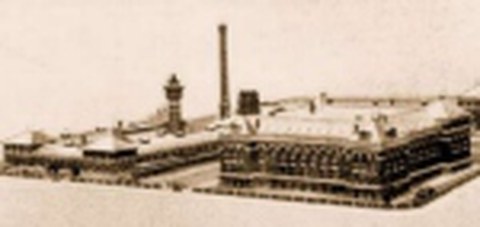
Building complex of the mechanical department
The Doctoral Degree Regulations take effect.
Friedrich Siemens (1826-1904) receives the first honorary doctorate from the TH Dresden. 1007 students study at the TH Dresden (Technical College of Dresden), including 232 foreigners, primarily from Eastern and Southern Europe, but also from overseas. According to the plans of Karl Weißbach (1841-1905), large buildings are erected for the Mechanical Engineering laboratories and the Electrotechnology Institute on the grounds at the foot of the Räcknitzer Höhe (on George Bähr Street and Helmholtz Street in the southern suburb that was being developed at the time) . Shortly thereafter, this complex is expanded to include an Electricity and Heating Power Station.
1902

Karl August Lingner
Arthur Schloßmann (1867-1932) is appointed Associate Professor of Physiological Chemistry and General Physiology. As early as 1897, Schloßmann, together with the major industrialist Karl August Lingner (1861-1916) and other Dresden citizens, founds the "Verein Kinderpoliklinik in Johannstadt mit Säuglingsheim" that erects the first in-patient institute for the care of infants in the world in 1898. The institute becomes the precedent for today's Children's Hospital of the Carl Gustav Carus Faculty of Medicine.
1907

Proof of enrolment of Johanna Weinmeister (Source: UA of the TUD, student file Johanna Weinmeister)
Women are now officially allowed to complete a full course of study at the TH Dresden. Johanna Weinmeister (1887-1940) from Tharandt began studying to become a teacher at the TH Dresden and in 1913 was the first female student to obtain a university degree. The state examination she passed for the higher education authority was the basis for her later successful work as a grammar school teacher in Dresden and in Annaberg (Erzgeb.).
1913
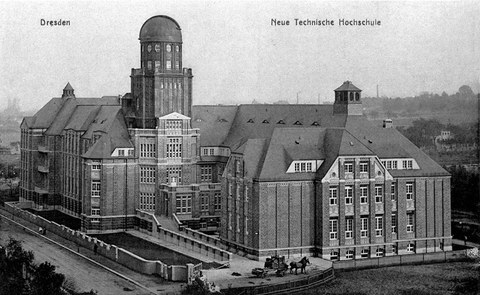
Building complex of the civil engineering department
The Faculty of Civil Engineering receives a large and representative new building, known today as "Beyer-Bau".
1914/18
322 members of the College are killed in battle during World War I in their role as enlisted men, non-commissioned officers, and officers. Among them is fighter pilot and former TH Dresden student Max Immelmann (1890–1916).
1918

Institute of Automotive Engineering
The Institute of Automotive Engineering is founded under the direction of Adolph Nägel (1875–1939).
1919
The Institute of Metallurgy and Materials Science is founded.
20s
1919/20
Introduction of the Foreign Studies Seminar.
1921

Statutes of the "Society of Sponsors and Friends of the Technical College of Dresden"
Founding of the "Society of Sponsors and Friends of the Technical College of Dresden", which the leading representatives of the Saxon State Government, industry, and banks join.
Establishment of the association "Economic Aid for the German Student Body" (since 1929 known as the "Deutsches Studentenwerk" at the TH Dresden). After the first successful efforts in the form of the "Dresden University Economic Society," this Dresden student self-help organization develops into one of the leading organizations of its kind in Germany. The General Department is separated from the Mathematics-Natural Sciences Department.
1922
Economics becomes a subject in the General Department of the TH Dresden. As opposed to at the universities, the focus at TH Dresden is not only on technical subjects, but also on Industrial Psychology and Psychotechnology.
1923
Incorporation of the College of Education Dresden-Strehlen into the General Department of the College (as of 1925 known as the Department of Cultural Studies). Economics, Political Science, Jurisprudence, Pedagogy, History, Art History, Comparative Linguistics, and Comparative Literature are firmly established at the TH. The university character of the college thereby steadily grows.
1924
Founding of the Institute of Measurement Engineering and Interchangeable Manufacture under the direction of Georg Berndt (1880-1972). Expansion of the Physics Institute, including setting up the Laboratory for Applied Radiography.
1925
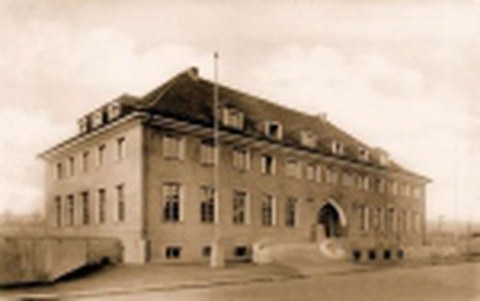
Residence hall at Mommsenstraße
Completion of the residence hall on the site donated by Theodor Bienert.
1928
Under the rectorship of Adolph Nägel, the TH Dresden celebrates its 100th anniversary on June 4, 1928. The university now has 63 full, 22 associate, and 17 honorary professors. 24 private lecturers are also teaching. The number of students reaches 2705, with an additional 332 students attending and sitting in on lectures.
1929
By ministerial decree, the Tharandt Forestry Academy (later called the Forestry College), founded by Heinrich Cotta (1763-1844) and one of the oldest academic training institutions for forestry in the world, is annexed to the TH Dresden as a department.
30s and 40s
1933/34

Viktor Klemperer - Romance Studies at the Department of Cultural Studies
The College is forced into line and the Principle of Leadership is introduced. Because of the "Law for the Reestablishment of Permanent Civil Service", famous university teachers are forced out of their posts and suffer reprisals. Among them are the physicist and discoverer of the crystal photon effect, Harry Dember (1882-1943), the romanist Victor Klemperer (1881-1960), the doctor and hygienist Rainer Fetscher (1895-1945), the political scientist Robert Wilbrandt (1875-1954), and Paul Luchtenberg (1890-1973), professor of Pedagogy, Philosophy, and Psychology, and future co-founder of the FDP and Culture Secretary of North-Rhein Westphalia.
1936
The College of Education is separated from the TH Dresden.
1942
The College departments are renamed faculties:
- Faculty of General Science
- Faculty of Civil Engineering
- Faculty of Mechanical Engineering
- Faculty of Forestry Science
1945

Destroyed rectorate building of the TH Dresden
Air raids over Dresden on February 13 and 14, 1945 cause great loss of life at the university. Many buildings are heavily damaged or destroyed.Soviet occupation forces take control of the College. Most members of the Nazi Party (NSDAP) are fired from their posts as teachers or administrators. Some of those who are let go are later re-hired.
1946
The Technical College of Dresden reopens under the most difficult conditions. The internationally recognized Professor of the Bases of Mechanical Engineering and Conveying Engineering, Dr. Enno Heidebroek (1876-1955), becomes the first rector.
Setting up of:
- Faculty of Education
- Faculty of Municipal Economics
- Faculty of Forestry
491 students are enrolled with the permission of the Soviet Military Administration in Germany (SMAD) (453 students actually begin to study). They are taught by 42 university teachers, including several lecturers and assistants.
1949
7 Faculties are established (including the faculty that prepares young factory and agricultural workers for studying at universities that emerged from an institution for preliminary studies): Fakultät für Mathematik und Naturwissenschaften
- Faculty of Mathematics and Natural Sciences
- Faculty of Civil Engineering
- Faculty of Mechanical Engineering and Electrical Engineering
- Faculty of Economics and Traffic and Transportation Science
- Faculty of Forestry Science
- Faculty of Education and Cultural Studies
50s and 60s
1950
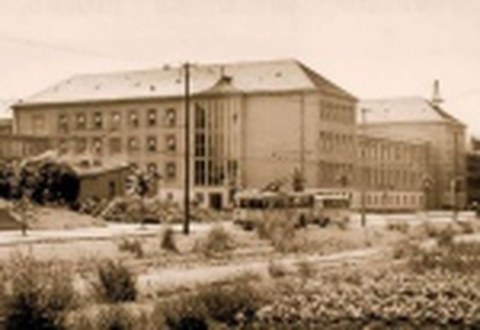
Building complex at Zelleschen Weg
On April 25, 1950, the foundation stone is laid for the new complex of buildings on the road "Zellescher Weg", which today houses institutes of the Faculty of Mathematics and Natural Sciences. Since 1961, a part of the building complex has been called "Willers-Bau". In 1994, the lecture hall building is named "Trefftz-Bau". On April 20, 1951, the Faculty of Transport and Communications is opened and the foundation stone is laid for the building complex on the street "Hettnerstraße".
1952

Heinrich Barkhausen
On the basis of a central decision, the Faculty of Transport and Communicationsat the Technical College of Dresden becomes the College of Transport and Communications in September 1952. The Faculty of Electrical Engineering is founded (until 1951 there was a Department of Electrical Engineering within the Faculty of Mechanical Engineering and Electrical Engineering). Among the most well-known scientists are Heinrich Barkhausen (1881-1956) and Ludwig Binder (1881-1958).
1954
The Department of Lightweight Construction is founded on instructions of the State Secretariat for Higher Education.
1955
Already in 1950, construction begins on the new Low-Voltage Institute called the Barkhausen Building. Until 1955, the first three stages of construction of the extensive building complex between Helmholtzstraße and Georg-Schumann-Straße are completed. The complex is used by the Department of Electrical Engineering. Founding of the Department of Nuclear Technology. It remains until 1962.
There are 9 Departments.
1956 – 1960

Andreas Schubert Building
On the North side of the road "Zellescher Weg" the "Andreas-Schubert-Bau" for the newly-founded Department of Nuclear Technology is erected. In 1962, this department is dissolved. Today it is used by various institutes of the Faculty of Mathematics and Natural Sciences.
1956
Aus der bisherigen Fakultät für Leichtbau der TH Dresden wird die Fakultät für Luftfahrtwesen gebildet. Im Jahre 1961 erfolgt deren Auflösung.
1957

Building complex of the former district court
The TH Dresden takes over the former District Court building. The construction and renovation of the building complex that was heavily destroyed in the war lasts until 1961. Primary users are the Faculties of Mechanical and Civil Engineering, Hydroscience and Forestry. Since 1961 it is called "Georg Schumann Bau". After 1990, parts of the building complex are renamed "Hülsse-Bau" and "Tillich-Bau".
1961
The Technical College of Dresden receives the status of Technical University. During the ceremonies on October 5, 1961, the rectorship is given from Werner Gruner (1904-1995) to Kurt Schwabe (1905-1983). Kurt Schwabe was the leading sponsor of the founding of the university. 10,741 students are registered, of which 4 per cent are foreigners.
1965

Barkhausen Building
The Technical College of Dresden receives the status of Technical University. During the ceremonies on October 5, 1961, the rectorship is given from Werner Gruner (1904-1995) to Kurt Schwabe (1905-1983). Kurt Schwabe was the leading sponsor of the founding of the university. 10,741 students are registered, of which 4 per cent are foreigners.
1968
In accordance with the 3rd University Reform, the structure of the TU Dresden (Dresden University of Technology) is also radically changed. Structures which have grown over history are negated under increasing party-political influence. The traditional scientific institutes are done away with. The Departments lose their original significance. 22 Sections are formed.
80s and 90s
1986
The Dresden Engineering University, rich in tradition and founded in 1861 as a trade school, is united with the TU Dresden and becomes the Center for Information Studies of the university system of the GDR. At the end of 1990, the Faculty of Computer Science is founded.
1990
Setting up of Faculties (February 12, 1990):
- Faculty of Social Sciences
- Faculty of Natural Sciences and Mathematics
- Faculty of Electrical Engineering and Electronics
- Faculty of Mechanical Engineering
- Faculty of Construction, Hydroscience, and Forestry
Election of the new senate from the circle of chosen members of the Academic Council (February 26, 1990).
Election of Professor Günther Landgraf [2] of the Faculty of Mechanical Engineering to Rector by the Academic Council (Investiture on March 12, 1990).
11,220 students are registered, of which 8.6 % are foreigners.
1991

Founding of the Faculty of Medicine
The Senior Governmental Director Alfred Post, formerly Vice-Chancellor of the Universität-Gesamthochschule Essen, becomes Chancellor of TU Dresden. The reconstruction of the University Administration begins. 13,000 students are enrolled.
Beginning of the integration of the "Karl Friedrich Wilhelm Wander" College of Education and the university part of the "Friedrich List" College of Transport and Communications into the TU Dresden. Preparation of the founding of a Faculty of Medicine at the TU Dresden.
Festive refounding of the Society of Sponsors and Friends of the Dresden University of Technology. The first founding celebrates its 70th anniversary. The TU Dresden becomes a member of the German Research Association (DFG).
Founding of the Academy of Further Education and Transfer of Knowledge at the Dresden University of Technology e. V.
1991/94
Confirmation and newfounding of the following faculties on the basis of the Law concerning the Structure of the University System and the Universities in the Free State of Saxony of April 10, 1992
- Faculty of Mathematics and Natural Sciences
- Faculty of Mechanical Engineering
- Faculty of Electrical Engineering
- Faculty of Arts and Social Sciences (until April 30, 1993)
- Faculty of Philosophy
Result of inclusion of parts of the - Faculty of Arts and Social Sciences (April 30 / May 1,1993) - Faculty of Linguistics and Literature
Result of take over of parts of the Faculty of Arts and Social Sciences (April 30 / May 1,1993) - Faculty of Computer Science
November 6, 1990 founding of the faculty; celebration on April 18, 1991 - Faculty of Education Sciences
July 9, 1993, founding of the Faculty - Faculty of Law
February 12, 1991 founding of the Faculty; celebration on March 7, 1991 - Faculty of Transport and Communications "Friedrich List"
November 6, 1992 founding of the Faculty and celebration - Faculty of Economics and Business Management
October 12, 1993 founding of the Faculty - Faculty of Medicine Carl Gustav Carus
October 1, 1993 founding of the Faculty; October 25, 1993 celebration - Faculty of Construction, Hydroscience, and Forestry
Dissolved in 1994. Formation of three new Faculties:- Faculty of Forestry, Water Science, and Geosciences (February 21, 1994)
- Faculty of Civil Engineering (January 1, 1994)
- Faculty of Architecture (May 17, 1994)
1993
Academic Council meets at the TU Dresden and for the first time in the new Federal States. The Hannah Arendt Institute for the Research of Totalitarianism is opened on the basis of a comprehensive resolution of the state parliament.
1994
Professor Achim Mehlhorn of the Faculty of Mathematics and Natural Sciences is elected Rector by the Council of the TU Dresden in June 1994 (Re-elected in 1997).
A Heart Center is opened at the Faculty of Medicine.
1995

TechnologieZentrumDresden GmbH
The Technology Center Dresden receives a new building as a science transfer partner of the University. The University opens the reconstructed Guest House on the street "Einsteinstraße".
1996
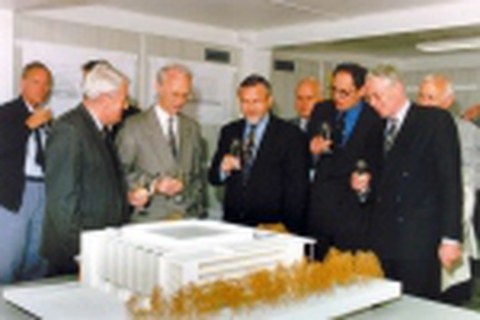
Architectural competition for a new Lecture Hall Centre at TU Dresden
- Foundation stone is laid for the new Lecture Hall Centre of the TU Dresden with four large lecture halls, twelve seminar rooms and one art room, with a total of 3,470 seats.
- Topping-out ceremony for another nursing house at the main entrance of the University Hospital and for a second Guest House at Weber Square.
- Founding of the Institute for Air and Space Technology.
- Founding of the Saxon State Library, State and University Library Dresden on the basis of a law.
- First heart transplant in Dresden (in 1977 the first liver transplant within the then COMMICON)
- Handing over of the Bone Marrow Transplant Center of the University Hospital.
- Festive celebration on the occasion of the 50th anniversary of the reopening of the TH/TU Dresden.
1997
The Foundation Association of German Science awarded the title "Reform University" to TU Dresden due to its innovative reform ideas and makes available to it the sum of 600 000 DM for continuing these activities. The university has developed a competent management structure; the distribution of resources to the faculties is carried out according to performance-related criteria and, compared to other universities, controlling is extremely well developed. Marketing and public relations are exemplary, according to the evaluation by the Foundation Association. Thus, TU Dresden is among the most innovative universities of Germany.
Roofing ceremony for the Auditorium Centre in Bergstraße.
Inaugural ceremony of the new building of the Cardio-Vascular Centre of Dresden on the site of the University Hospital "Carl Gustav Carus" (29 September 1999). It is financed by the private "Roland Ernst Foundation for Public Health" and by a real estate fund.
1998
Since January the High Performance Calculation Centre (ZHR), as a centrally located scientific institution, supports the faculties in their teaching and research tasks.

Hörsaalzentrum of the TU Dresden
The new Auditorium Centre of TU Dresden will open on 13 October 1998. Herewith, TU Dresden has at its disposal the, so far, largest and most modern Auditorium Centre of East Germany. Six lecture halls with a total of 2.840 seats, among them the auditorium maximum with 1.000 seats, as well as 10 seminar rooms and one drawing hall are available to professors and students.
1999

UN Secretary General Kofi Annan receives honorary doctorate
On 27 April 1999, Kofi Annan, the General Secretary of the United Nations, will be awarded the degree of honorary doctor of the TU Dresden in recognition of his excellent qualification in economics and his outstanding achievements in the planning and the implementation of the reorganisation of the UN as well as in the creation of citizen-friendly and quickly-reacting UN structures. With the degree of honorary doctor being conferred upon Kofi Annan, the international politician is honored by the Faculty of Economics for his academic and practical efforts in the propagation of sustained world-wide economisation based on social market economy.
The Media Design Center (MDC) of the University commences its work. As a centre of high competency the MDC offers research-relevant services in the field of virtual learning and teaching within and without the university.
Verleihung der Ehrendoktorwürde der TU Dresden an den UN-Generalsekretär Kofi Annan
The General Secretary of the United Nations, Mr. Kofi Annan, is awarded of the honorary doctoral degree
